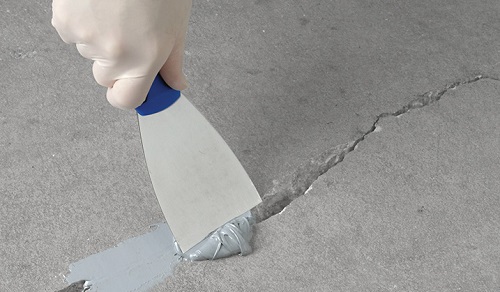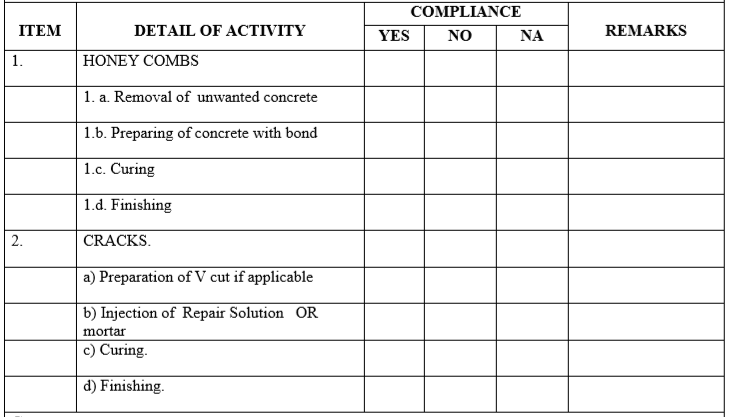This document describes the methods proposed to be used for the concrete repair activities that will be carried out as part of construction works for any kind of project.
During the concrete repairing works quality system will be operated conforming to related standards. Controls and checks will be established and documented in concrete repair form.
Repaired surface Inspection will be offered to client. All deficiencies will be logged, photographed and repaired. Separate Repair Log sheet will be maintained.
Roles & Responsibilities
Site manager will provide inputs to the project execution plan to ensure that strategies & philosophy are properly addressed.
Civil Works Manager is responsible for the overall management of the project construction team to ensure that safe and effective operations are conducted and properly documented.
Site engineer is overall responsible for safe execution of the whole job including:
- Confirming the installation location from schedule of approved construction drawings.
- Organizing of equipment’s and tools needed for the job.
- Assigning skilled personnel for the job.
- Sequence of activities to be carried out for the work as per this method of statement.
- Conduct inspection and surveillance.
- Notify to Contractor engineer for inspection as applicable.
- Ensure all Contractor and Company regulations are followed.
- Make sure that all personnel involved are in safe working condition.
Work Supervisor is responsible for safe execution of the following activities:
- Conduct TSTI with the concerned work force prior to start the work.
- Ensure that relevant work permits for the job are obtained prior to start the work.
- Conduct daily toolbox talks for the entire work force prior to start day work.
- Assigning a competent work crew for specific activities, details of activities and task information will be given to the work crew.
- Organizing tools and equipment needed to the work site.
- Inspection and supervision of work.
- Ensure all Contractor and Company safety regulations are followed as applicable.
QA/QC Engineer / Inspector is responsible for:
Assurance of approved methods and materials are being used and conformance of the specifications.
Stage inspections and surveillance in accordance with ITP and assurance of quality of work as per specification and erection procedures.
Incoming material inspection and review of test certificates.
References and Codes
- Local Construction Standard
- Specifications for Reinforced Concrete Foundations and Structures
- ASTM 546 Concrete Repair Guide
- Bonding Material Vendor Specifications
- Other specifications and procedures of contractor, client and consultant as applicable
Tools & Equipment’s
Following equipment and tools shall be arranged for the concrete repair works. All equipment will be inspected and approved by the Contractor, when required, and all personnel will be inducted and trained before and during the equipment mobilization.
- Disc cutter
- Electric/pneumatic breaker or hammer and chisel
- Wire brush
- Measuring jug
- Slow speed drill (400 or 500rpm)
- Mixing paddle
- Suitably sized mixing vessel
- Trowel
- Wooden float
- Steel or plastic finishing float or sponge
- Injection machine
- High speed percussion drill
- Hand held angle grinders
Health and Safety Requirements for Concrete Repair Work
Repairing works shall be in compliance with the local laws and regulations and international standards/codes, consultant and Contractor requirements and instructions.
All personnel will go through Safety Induction courses as well as other trainings as identified by their supervisor. A Job Safety Analysis (JSA) specific for this work including a Risk Assessment is prepared. Such JSA addresses the hazards associated with each task within the scope of this Method Statement and introduces the controls that will be implemented to reduce the associated risks to acceptable levels. The JSA will be used by the Site Supervisor as the basis of his TSTI / TSTO and Toolbox Talks etc.
All personnel will have PPE required for their specific tasks in addition to the minimum PPE (coveralls, safety goggles, safety shoes, high-visibility vests, gloves) at site at all times as required.
In the event of a release, fire or explosion, employees will secure their area and evacuate to the nearest muster point. Once all employees are evacuated the supervisor will conduct a headcount to verify all employees are out of harm’s way. The supervision will report this to Contractor. Emergency Contact numbers for will be posted onsite.
All vehicles and equipment used for the concrete repair work will be inspected and certified as required.
Drivers and operators will be competent and will have attended all required trainings set forth in project procedures and specifications.
Concrete Repair Sequence of Work
As per the the project quality procedures concrete repair is a HOLD POINT in the ITP and only proprietary factory made approved materials shall be used for the repair.
The surface preparation of the concrete to be repaired and the mixing, application and curing of the (proprietary) repair mortars/(micro) concrete shall be as per manufacturers requirements/recommendations and /or the specifications applicable for concrete shall be followed if specific requirements are not given by the manufacturer (e.g. curing).
All repair areas shall be covered from direct sunlight.
The repair shall only be carried out after the curing has been completed.

Repair of Concrete Cracks (Cracks width greater than 0.3mm)
Note: Cracks with a width exceeding 0.3mm are not confirming to the project specification and a Non Conformance Report (NCR) shall be raised.
Open the crack, by chiseling a V–cut, to a depth where the crack visually seems to stop; however the maximum depth for chiseling is 20mm. The crack shall be cleaned with compressed air. Fill the crack up with water and observe whether or not the crack continues by looking for air bubbles in the water due to air escaping out of the crack.
If air bubbles are observed, an approved low viscosity resin shall be poured into the crack as per manufactures recommendation until the crack is fully saturated with the resin.
Repair / seal the V-cut of the crack, after injection, with an approved shrinkage controlled structural grade cementitious repair mortar system (approved is Renderoc SXtra).
If no air bubbles are observed, the V-cut shall only be repaired/sealed as per above. Where detection of a possible continuation of the crack with water filling is not possible (on vertical faces) the crack repair shall be discussed between consultant and contractor, looking for similarities with horizontal cracks in the same area. Where similarities are not found and/or agreed the crack shall be deemed to be deep and injected with epoxy and the V-cut further repaired/sealed as per above.
All cracks with a crack width between 0.1 and 0.3mm (Only for Non Coated Areas)
If the crack is reaching anchor bolts or box-outs, apply the same repair method as for cracks with a crack width of greater than 0.3mm.
Repair Of Minor Surface Deficiencies In The Concrete (Air Voids etc.)
Surface defects that can be enclosed by a 50mm circle and in which circle the concrete cover is not reduced by more than 10mm are defined as minor surface deficiencies. These minor voids shall be filled with fine mortar incorporating polyvinyl acetate (approved is Renderoc RF, for a maximum thickness of 5mm).
Repair Of Major Surface Deficiencies In The Concrete
Note: Major surface deficiencies are not confirming to the specification and a Non Conformance Report (NCR) shall be raised. Major surfaces deficiencies are deficiencies that cannot be enclosed by a circle of 50mm and/or where the concrete cover has been reduced by more than 10mm and up to the rebar zone (no rebar exposed).
Defective concrete shall be removed up to sound concrete. These major deficiencies shall be repaired by an approved shrinkage controlled structural grade cementitious mortar system (approved is Renderoc SXtra).
Major Concrete Repair
Note: Major concrete repairs are not confirming to the specification and a Non Conformance Report (NCR) shall be raised.
Areas where after removal of the defective concrete the rebar becomes exposed and/or where the extend of the repair is such that formwork has to be used are defined as Major Concrete Repairs. The defective concrete shall be removed up to sound concrete.
If the defective concrete extends to the rebar a clear gap of at least 20mm shall be created behind the rear face of the rebar, such that a gloved hand can comfortably reach behind the main bars.
All exposed rebar shall be carefully cleaned by wire brushing before the repair and the concrete faces to be scabbled and wetted as per requirement/recommendation of the manufacturer of the repair micro concrete.
Curing of Concrete Repairing
Curing will be done as per Manufacturer recommendation. Renderoc BF generally needs to be protected by polythene sheets.
In Hot & windy climate shall be coated with Nitocote PE 135. Nitocote PE 135 need not removed for further surface coating as per Manufacturer recommendation. Curing with damped Hessian is to be done for one day. This coating can be done after one day in wet damped surface also.
Inspection Form For Concrete Honey Combs & Cracks

Discover more from Project Management 123
Subscribe to get the latest posts sent to your email.